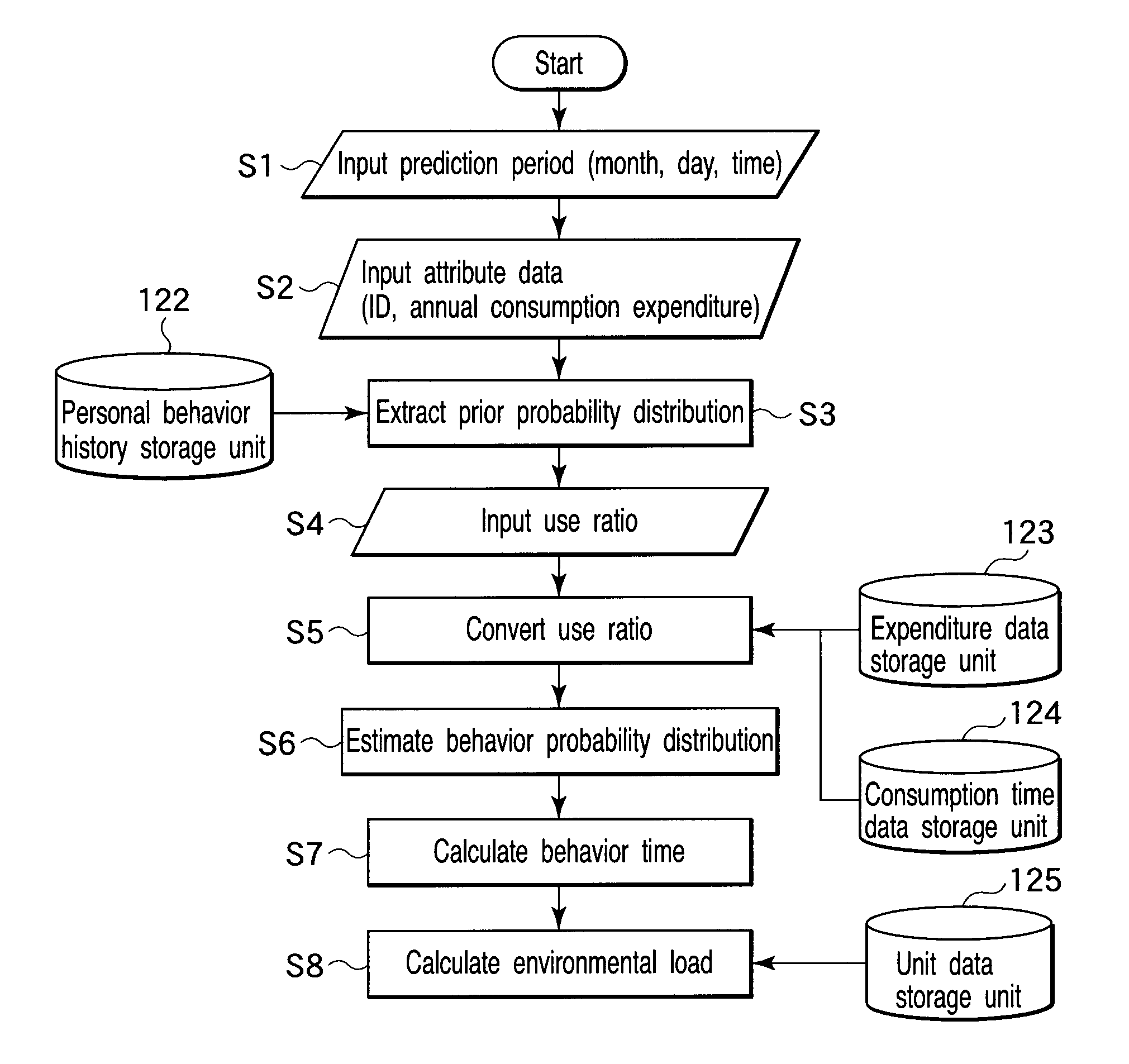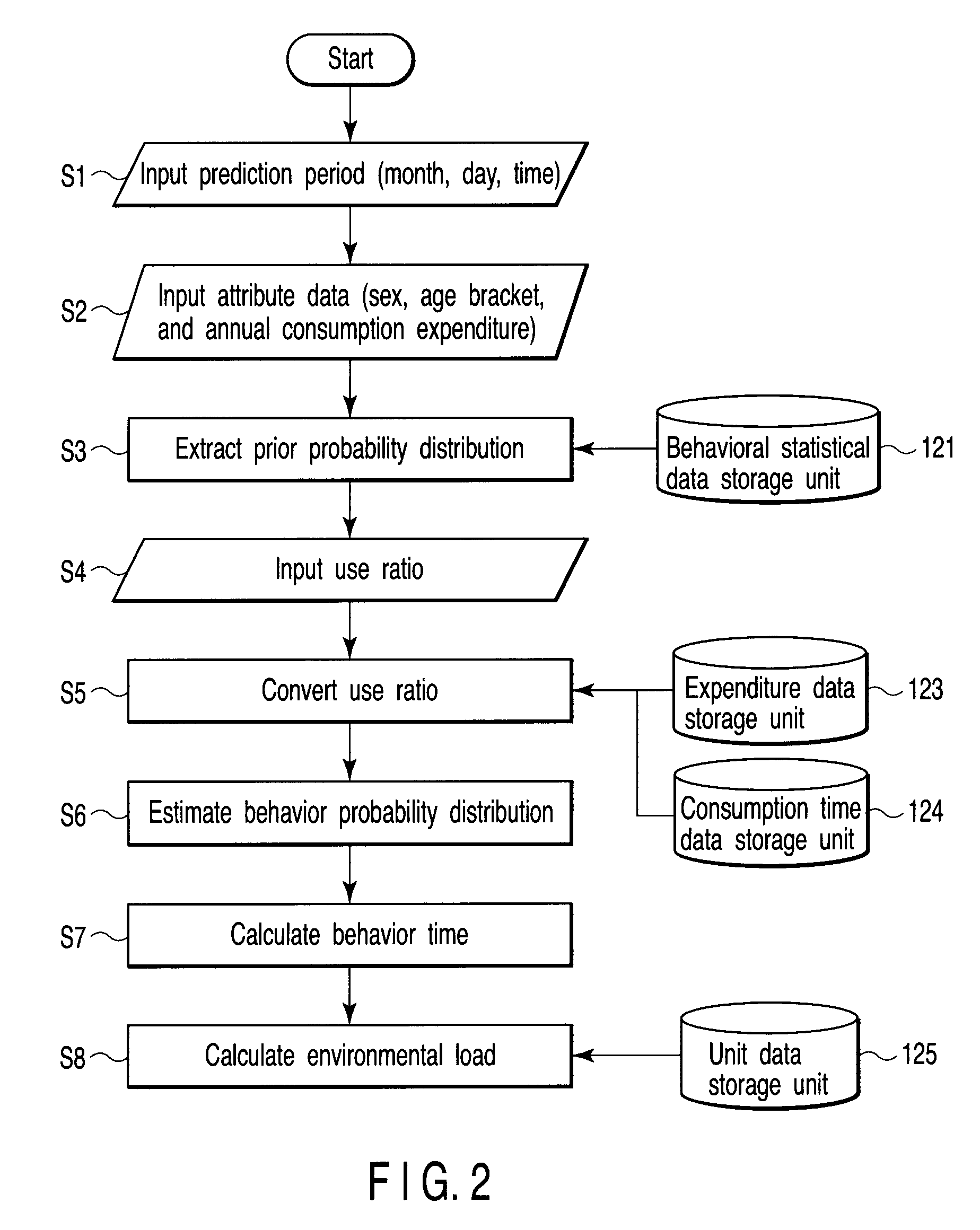Behavior prediction apparatus and method
a technology of behavior prediction and equipment, applied in the direction of pulse technique, instruments, computing models, etc., can solve the problems of insufficient measures on the manufacturer side to establish a sustainable society, people cannot always select and practice living behaviors with less environmental load, transportation means to take for a certain place and how to use surplus time are difficult to uniquely determin
- Summary
- Abstract
- Description
- Claims
- Application Information
AI Technical Summary
Benefits of technology
Problems solved by technology
Method used
Image
Examples
first embodiment
[0035]As shown in FIG. 1, the behavior prediction system roughly includes a behavior prediction apparatus 1, input unit 2, and display unit 3. The behavior prediction apparatus 1 includes a data storage unit 101, condition input unit 102, prior probability extraction unit 103, use ratio conversion unit 104, behavior probability estimation unit 105, behavior time calculation unit 106, value calculation unit 107, result output unit 108, and memory 109.
[0036]The data storage unit 101 includes a behavioral statistical data storage unit 121, personal behavior history storage unit 122, expenditure data storage unit 123, consumption time data storage unit 124, unit data storage unit 125, and reference data storage unit 126.
[0037]In the behavior prediction system according to the first embodiment, the data storage unit 101 need only include at least the behavioral statistical data storage unit 121, expenditure data storage unit 123, consumption time data storage unit 124, and unit data stor...
second embodiment
[0086]In estimating the behavior probability distribution in step S6 in FIG. 2, if a behavior time during the prediction period can be predicted in advance for a specific behavior, constraints are given individually to an estimated behavior probability pi of the behavior i on the basis of the predicted behavior time.
[0087]In this case, it is also possible to give constraints individually to the behavior probabilities pi of behaviors belonging to the behavior group of interest or any other behaviors i on the basis of the predicted behavior times of the behaviors during the prediction period.
[0088]For example, in step S4 in FIG. 2, an input unit 2 inputs the predicted value of the behavior time or the predicted range (upper and lower limits) of the behavior time for the specific behavior whose behavior time during the prediction period is predicted in advance. FIG. 8 shows a display example of an input window (displayed on a display unit 3) at this time.
[0089]Let T be the prediction p...
third embodiment
[0094]In the first embodiment, a priori probability distribution is extracted from a standard behavior pattern statistically obtained from many data. In the third embodiment, a priori probability distribution is extracted not from a standard behavior pattern but from the behavior history data of a specific person in step S3 in FIG. 9.
[0095]Extracting a priori probability distribution extracted not from a standard behavior pattern but from the actual behavior history data of a specific person allows to accurately predict the behavior of the specific person.
[0096]A personal behavior history storage unit 122 stores the same behavior pattern as in FIGS. 3, 4A and 4B in correspondence with identification information to identify an individual, including a name, ID number, and annual consumption expenditure.
[0097]In step S2 in FIG. 9, data such as an ID number to identify an individual is input as attribute data. In step S3, a priori probability extraction unit 103 extracts a priori probab...
PUM
 Login to View More
Login to View More Abstract
Description
Claims
Application Information
 Login to View More
Login to View More - R&D
- Intellectual Property
- Life Sciences
- Materials
- Tech Scout
- Unparalleled Data Quality
- Higher Quality Content
- 60% Fewer Hallucinations
Browse by: Latest US Patents, China's latest patents, Technical Efficacy Thesaurus, Application Domain, Technology Topic, Popular Technical Reports.
© 2025 PatSnap. All rights reserved.Legal|Privacy policy|Modern Slavery Act Transparency Statement|Sitemap|About US| Contact US: help@patsnap.com



